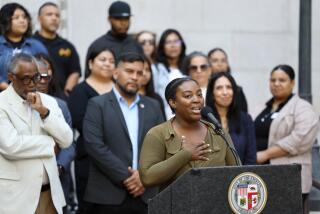Putting the Poor in Driver’s Seat
VENTURA — The first thing Kelly Phillips did was throw her two children in the car and head out for tacos.
“Our big night out,” she joked.
But it was.
For Phillips, who has spent the past two years on welfare, the car is her ticket to a good job and a better life for Jimmy, 4, and Arie, 6.
The Simi Valley woman is one of three single mothers selected for an innovative Ventura County welfare-to-work program that uses county money to guarantee car loans.
With a four-year loan through the Ventura County Federal Credit Union, Phillips will pay $63 a month to buy and insure her 1986 Chevy Cavalier, a donated county fleet car with a low “Blue Book” value of $1,850.
“There’s no way I could have walked onto a lot to get a car,” Phillips said. “They would have told me I was crazy. They would have laughed me off the lot.”
She will use the car to get to a computer class that she plans to complete in June. Her dream is to run a five-star hotel, but for now she will settle for a data-entry job and an income that can support her and her children.
That’s exactly what the Ventura County Board of Supervisors had in mind in December when it approved the pilot program designed to help usher welfare recipients off the dole and into self-sufficiency.
So far, the county has set aside $7,000 to guarantee the three car loans, an amount that officials admit is just a drop in the bucket.
They estimate that half of the 8,600 county families on welfare do not have reliable cars. Officials are applying for a $2.2-million federal grant to provide vanpools and other means of transportation for welfare recipients.
Transportation often is the biggest obstacle that welfare recipients face as they try to comply with state and federal welfare reform legislation, which in most cases limits public aid to two years, experts say.
In many cases, welfare recipients live far from available jobs. Night and weekend shifts often do not jibe with county bus schedules, especially when a stop at a child-care provider is also required on the way to and from work.
In Ventura, Los Angeles, San Bernardino, Riverside and Orange counties, 25% of those receiving public aid own cars, according to the Southern California Assn. of Governments. And only about three in 10 can rely on public transportation, carpools or vanpools.
Though in effect almost nowhere else in California, arrangements like Ventura County’s new welfare-to-work program are not unheard of nationally.
Anne Arundel County in Maryland began a “Wheels to Work” program several years ago. Recipients there are issued lump-sum welfare grants to repair, register and insure cars donated to local charities as tax write-offs.
The new Ventura County program differs in that it requires welfare recipients to pay for the cars, a move spurred in part by criticism that the program was just another form of welfare, said Jim Becker, the program’s coordinator.
Carol A. Harris, president and chief executive officer of the county credit union, stresses that the terms of the three loans issued for the pilot program are the same that anyone would pay.
The only difference is that the county is guaranteeing the loans.
Eventually, the county plans to transfer the loan program to a nonprofit agency, which could take in donated cars, repair them and sell them to recipients.
The three loan recipients were chosen from among 25 people on welfare whose names were submitted by social workers, based on their driving records and credit history.
Phillips has been receiving public aid since a breakup with her boyfriend left her with no car, no job and two toddlers to care for.
She said the car, which she will pay for with a portion of her monthly welfare check until she gets a job, will free her from depending on friends, relatives and bus schedules for rides. And it should open the door to better-paying jobs.
“I’m dying to get off welfare,” Phillips said. “I never wanted to get on in the first place.”
Times correspondent Jason Takenouchi contributed to this story.
More to Read
Sign up for Essential California
The most important California stories and recommendations in your inbox every morning.
You may occasionally receive promotional content from the Los Angeles Times.










